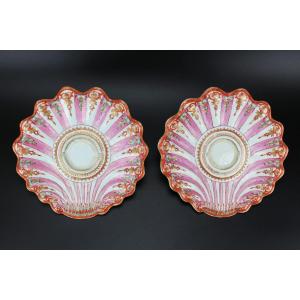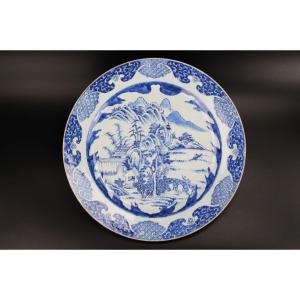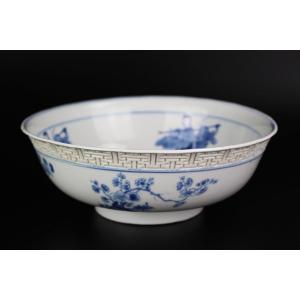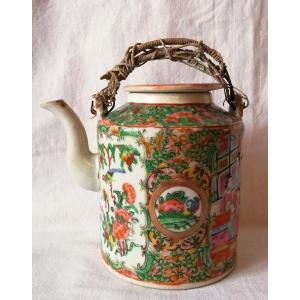Arita, Japan, Edo period, late 18th/early 19th century.
A set of two bowls and two dishes with rounded sides and flaring foliated brown-edged rim. A moulded low relief decoration on the border with scrolls following the shape of the rim, on the outer part of the well three sages surrounded by bamboo with rocks underneath and clouds above them. A raised medaillon in the centre of the well with an underglaze blue decoration of an Aranda or westerner accompanied by a dog. The figure is probably a harlequin or jester, with large hat and jacket strewn with buttons.
The use of negative space smartly emphasizes the decoration of the westerner in the middle surrounded by the three sages making this dish the perfect example of east meets west. The base has an unidentified single character mark.
Impey ascribed these dishes as Kakiemon type, dating them to the 19th century. In the Shibata collection catalogue however they are dated 1770-1790.
Provenance:
Christie’s sale 5967, 13th May 2009 (sticker).
Lit:
A similar dish is in the Ashmolean Museum collection, accession no. EA1978.789 and illustrated in Oliver Impey: Japanese Export Porcelain, Catalogue of the Collection of the Ashmolean Museum, Oxford, 2002, p. 232, pl. 402.
Another example is in the Frelinghuysen collection and illustrated in Becky Macguire: Four Centuries of Blue & White - The Frelinghuysen Collection of Chinese and Japanese Export Porcelain, 2023, p. 343, pl. 290.
For more examples of dishes and bowls with this pattern, see:
Shibata Collection part 1 (Kyushu Ceramic Museum, 2003) p. 172, pl. 460.
Shibata Collection part 2 (Kyushu Ceramic Museum, 2003) p. 303, pl. 800.
Shibata Collection part 4 (Kyushu Ceramic Museum, 2003) p. 168, pl. 37.
Shibata Collection part 8 (Kyushu Ceramic Museum, 2003) p. 126, pl. 233.
Dimensions:
Dishes:
Diameter 21.5 cm, height 3.5 cm.
Bowls:
Diameter 15.6 cm, height 4.5 cm.
Condition:
Perfect condition.
Worldwide registered and insured shipping.
Take a look at our other listings for more Asian art and antiques.
Inv. No: MW103














































 Le Magazine de PROANTIC
Le Magazine de PROANTIC TRÉSORS Magazine
TRÉSORS Magazine Rivista Artiquariato
Rivista Artiquariato